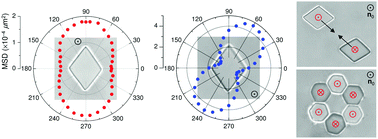Repulsion–attraction switching of nematic colloids formed by liquid crystal dispersions of polygonal prisms
Abstract
Self-assembly of colloidal particles due to elastic interactions in nematic liquid crystals promises tunable composite materials and can be guided by exploiting surface functionalization, geometric shape and topology, though these means of controlling self-assembly remain limited. Here, we realize low-symmetry achiral and chiral elastic colloids in the nematic liquid crystals using colloidal polygonal concave and convex prisms. We show that the controlled pinning of disclinations at the prism edges alters the symmetry of director distortions around the prisms and their orientation with respect to the far-field director. The controlled localization of the disclinations at the prism's edges significantly influences the anisotropy of the diffusion properties of prisms dispersed in liquid crystals and allows one to modify their self-assembly. We show that elastic interactions between polygonal prisms can be switched between repulsive and attractive just by controlled re-pinning the disclinations at different edges using laser tweezers. Our findings demonstrate that elastic interactions between colloidal particles dispersed in nematic liquid crystals are sensitive to the topologically equivalent but geometrically rich controlled configurations of the particle-induced defects.



 Please wait while we load your content...
Please wait while we load your content...